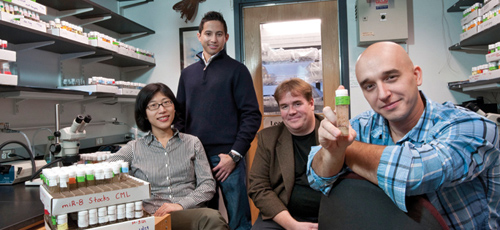Labs that probe tiny molecules called microRNAs often resemble online dating services. They use software to search for genetic sequences that match the microRNAs, scanning the genome for potential binding sites. But any Match.com veteran knows that cyberspace pairings seldom translate into chemistry in the real world. Dating service subscribers must meet their matches in person to confirm a connection. The same holds true for microRNAs.

Labs can finally assess their matchmaking abilities, using a new, versatile tool developed by cell biology instructor Tudor Fulga and graduate student Carlos Loya in the laboratory of David Van Vactor, HMS professor of cell biology. They reported their technology in the December issue of the journal Nature Methods. The “Drosophila microRNA sponge” allows a scientist to quickly test predictions about individual microRNAs in living fruit flies.
“Researchers can activate the microRNA sponge in a specific tissue when the fly reaches a particular phase of development,” said last author Fulga, who conceived the tool.
“The scientific community can finally make a dent in the pile of predictions about microRNAs, which require validation in organisms,” added Van Vactor.
In a sense, microRNAs are the ideal clients for a matchmaker. They are simple souls, comprising just 21 to 24 letters of the genetic alphabet, and they follow a few basic rules when hunting for partners. Scientists were thus able to develop computer programs to scan the genome for potential microRNA targets.
The field exploded when these scans suggested that microRNAs collectively bind to and disrupt the templates for thousands of different proteins. Indeed, this class of RNAs may play a role in every major biological pathway.
But researchers ran into hurdles when they moved back to the lab bench to test their predictions. Tried-and-true techniques for manipulating genes and monitoring the results were difficult with these tiny microRNA genes. When labs mutated the gene for a particular microRNA, for example, other related microRNAs often came to the rescue and performed the duties of the disabled family member, thus undermining the experiment. While a few teams succeeded in validating the functions of specific microRNAs, many avoided the task altogether.
With the Drosophila microRNA sponge, that may change. Fulga designed a perfect marriage between tools from Phillip Sharp’s lab at MIT and Norbert Perrimon’s lab at HMS. The result was a method that uses spatio-temporal specificity in fruit flies to keep microRNAs away from their targets. First, he built a series of “sponge” genes, which include DNA sequences that match key portions of particular microRNAs. Each sponge binds to, or soaks up, a specific microRNA or family of microRNAs, keeping the regulatory molecules occupied.
Loya and Fulga took the new Drosophila microRNA sponge for a high-performance test drive, exploring the role of a microRNA called miR-8 that postdoctoral fellow Cecilia Lu and Loya found was important for the formation of junctions between muscle and nerve cells. The team then made a surprising discovery—though miR-8 is present on both sides of the synapse, it only plays a regulatory role on the receiving end.
Second, he and Loya employed a system called GAL4/UAS to create custom lines of fruit flies. Each line contained a single sponge, programmed to spring into action in a specific tissue when given the green light by researchers.
Loya and Fulga took the new Drosophila microRNA sponge for a high-performance test drive, exploring the role of a microRNA called miR-8 that postdoctoral fellow Cecilia Lu and Loya found was important for the formation of junctions between muscle and nerve cells. The team then made a surprising discovery—though miR-8 is present on both sides of the synapse, it only plays a regulatory role on the receiving end.
“This demonstrates why it is so important to test our predictions in an organism,” said Van Vactor
“Until now, we haven’t had a general method or tool to drill down into the details about the biological roles of individual microRNAs,” said Josh Dubnau, an assistant professor at Cold Spring Harbor Laboratory who was not involved in the study. Dubnau is exploring the role of a particular microRNA in memory formation. “The in vivo sponge method provides that.”
Lab Leadership
When a lab has a study published, it shows success on many different levels. One of them is mentoring. Focus posed several questions about mentoring to David Van Vactor, HMS professor of cell biology, since he not only runs a lab but works with students in the surrounding community to make science come alive.
How does mentoring factor into your work as a principal investigator?
Mentoring is a cornerstone of being a PI and a team leader. I’ve made lots of mistakes, but hope to keep learning.
Who was your role model when you were growing up?
I was fortunate to have many important role models. In the academic realm, I was definitely inspired by my paternal grandfather: a composer, conductor and chairman/founder of the Fine Arts Department at the University of Tennessee, Knoxville. My grandfather also set up an outreach program for children—bringing the symphony orchestra to schools in order to make serious music accessible.
From your experience working in the community, who are your role models these days?
I am always learning from my colleagues, at every level. That’s the beauty of what we do. Education demands an open mind—on both the sending and receiving ends.
For more information, students may contact David Van Vactor at davie_vanvactor@hms.harvard.edu.
Conflict Disclosure: The authors declare no conflicts of interest
Funding Sources: The National Institute of Neurological Disorders and Stroke; the authors are solely responsible for the content of this work.


